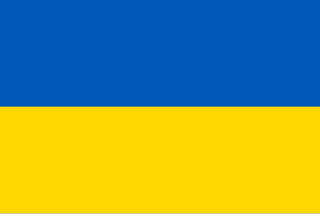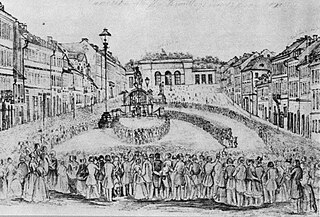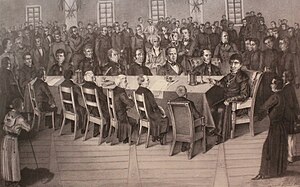
Ruthenian and Ruthene are exonyms of Latin origin, formerly used in Eastern and Central Europe as common ethnonyms for East Slavs, particularly during the late medieval and early modern periods. The Latin term Rutheni was used in medieval sources to describe all Eastern Slavs of the Grand Duchy of Lithuania, as an exonym for people of the former Kievan Rus', thus including ancestors of the modern Belarusians, Rusyns and Ukrainians. The use of Ruthenian and related exonyms continued through the early modern period, developing several distinctive meanings, both in terms of their regional scopes and additional religious connotations.

The national flag of Ukraine consists of equally sized horizontal bands of blue and yellow.

Ternopil Oblast, also referred to as Ternopilshchyna or Ternopillia, is an oblast (province) of Ukraine. Its administrative center is Ternopil, through which flows the Seret, a tributary of the Dniester. Population: 1,021,713.

The Kingdom of Galicia and Lodomeria, also known as Austrian Galicia or colloquially Austrian Poland, was a constituent possession of the Habsburg monarchy in the historical region of Galicia in Eastern Europe. The crownland was established in 1772. The lands were annexed from the Polish-Lithuanian Commonwealth as part of the First Partition of Poland. In 1804 it became a crownland of the newly proclaimed Austrian Empire. From 1867 it was a crownland within the Cisleithanian or Austrian half of the dual monarchy of Austria-Hungary. It maintained a degree of provincial autonomy. Its status remained unchanged until the dissolution of the monarchy in 1918.

The coat of arms of Ukraine is a blue shield with a golden trident. It is colloquially known as the tryzub.

The Polish–Ukrainian War, from November 1918 to July 1919, was a conflict between the Second Polish Republic and Ukrainian forces.

Ukrainian Galician Army, was the Ukrainian military of the West Ukrainian People's Republic during and after the Polish-Ukrainian War. It was called the "Galician army" initially. Dissatisfied with the alliance of Ukraine and Poland it joined the army of Anton Denikin in November 1919, was renamed the "Ukrainian Galician Army" and later joined the Red Army as the "Red Ukrainian Galician Army" in 1920.

The Prague Slavic Congress of 1848 took place in Prague, Austrian Empire between 2 June and 12 June 1848. It was the first occasion on which voices from nearly all Slav populations of Europe were heard in one place.
Galician Russophilia or Moscophilia was a cultural and political movement largely in the Kingdom of Galicia and Lodomeria, Austria-Hungary. This ideology emphasized that since the Eastern Slavic people of Galicia were descendants of the people of Kievan Rus' (Ruthenians), and followers of Eastern Christianity, they were thus a branch of the Russian people. The movement was part of the larger Pan-Slavism that was developing in the late 19th century. Russophilia was largely a backlash against Polonisation and Magyarisation that was largely blamed on the landlords and associated with Roman Catholicism.

Michael Levytsky ; 17 February, 1774 – 14 January, 1858) was the Metropolitan Archbishop of the Ukrainian Greek Catholic Church from 1816 until his death in 1858 and a Cardinal of the Catholic Church. He was from a Ukrainian Greek Catholic sacerdotal family and nobility with the herbu, de Rogale.

Ivan Mykolaiovych Vahylevych was a Ukrainian Romantic poet, philologist, and ethnographer of the Galician revival in Western Ukraine.

Hryhoriy Yakhymovych was the Metropolitan Archbishop of the Ukrainian Greek Catholic Church, and also a leading figure in the Ukrainian National Revival, from 1860 until his death in 1863.

23 August is celebrated as the Day of the National Flag in Ukraine; since in 2004.
With the arrival of the Hungarians into the heart of the Central European Plain around 899, Slavic tribes of Vistulans, White Croats, and Lendians found themselves under Hungarian rule. In 955 those areas north of the Carpathian Mountains constituted an autonomous part of the Duchy of Bohemia and remained so until around 972, when the first Polish territorial claims began to emerge. This area was mentioned in 981, when Vladimir the Great of Kievan Rus' claimed the area on his westward way. In the 11th century the area belonged to Poland, then reverted to Kievan Rus'. However, at the end of the 12th century the Hungarian claims to the principality turned up. Finally Casimir III of Poland annexed it in 1340–1349. Low Germans from Prussia and Middle Germany settled parts of northern and western Galicia from the 13th to 18th centuries, although the vast majority of the historic province remained independent from German and Austrian rule.

The city of Lviv, Ukraine has had a series of town hall buildings since approximately 1357. These have for centuries been recognized landmarks of the community. The modern building located at Market Square, 1 is the residence of the Lviv City Council. It is included into a UNESCO World Heritage list as part of the Historic City Centre Ensemble.

The coat of arms of Carpatho-Ukraine is the official heraldic coat of arms of Zakarpattia Oblast in Ukraine. The coat of arms was initially adopted on 30 March 1920 along with coat of arms of other lands of Czechoslovakia. The Ukrainian version of the arms was adopted on 18 December 1990 as a revived coat of arms by Hungarian graphic artist Janos Reiti.
Ruthenian sobor, or Ruthenian Congress was a Polonophile Political Committee, based in Lviv and created on May 23, 1848 by Polish nobleman of Ukrainian origin "in the name of supporting harmony and unity in peace Motherland". Ruthenian sobor had 64 members strongly opposed the Polish-Ukrainian administrative partition of Galicia and collaborated with the Polish People's Council. Ruthenian sobor was opposite of the Supreme Ruthenian Council. It operated during the Spring of Nations time, and was dissolved with the reestablishment of the government control by fall that year.
Primate of Galicia and Lodomeria was the Catholic Church historical title of honor that existed in the Austrian Empire from 1817 until 1858 for the Roman Catholic Archdiocese of Lviv (1817–1848) and the Ruthenian Catholic Archeparchy of Lviv (1848–1858). Under this Primate were three ecclesiastical provinces of the different Catholic traditions: Armenian, Latin and Ruthenian in Halychyna.

The Ruthenian lion, also known as the Ukrainian lion or Galicianlion, is a golden lion on an azure background. The lion was featured on the historic coat of arms of the Kingdom of Galicia-Volhynia (Ruthenia), the Ruthenian Voivodeship and the Western Ukrainian People's Republic. During the revolutions in the Austrian Empire in 1848, it was restored as one of the national symbols of Ukrainians and the Ukrainian national liberation movement. Today it is featured on the coat of arms of the city of Lviv and its surrounding province, Lviv Oblast.















